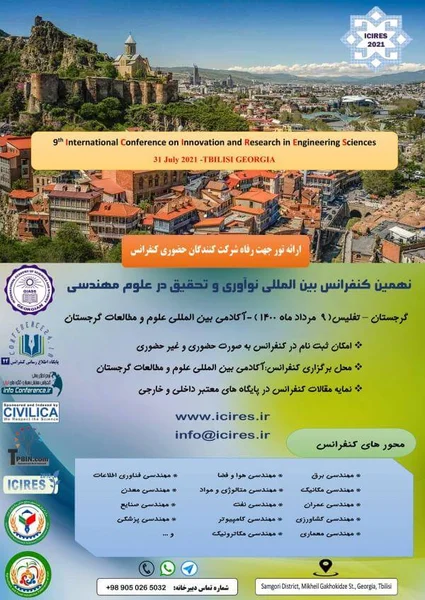-
useing of satellite image for exploration of haji-gak iron mine in bamiyan, afghanistan
جزئیات بیشتر مقاله- تاریخ ارائه: 1400/03/14
- تاریخ انتشار در تی پی بین: 1400/03/14
- تعداد بازدید: 174
- تعداد پرسش و پاسخ ها: 0
- شماره تماس دبیرخانه رویداد: -
useing of satellite image for exploration of haji-gak iron mine in bamiyan, afghanistan
the haji-gak mine is the largest iron ore mine in afghanistan. located in the center of afghanistan, which has the gyological life of paliozavi and pirm .he rocks of mytasomatic-hydrothermal-sedimentary origin. types of iron minerals, including magnetite, hematite, magnasite, and amphibolite and qaurtz. the combination of remote sensing and field operations data is a powerful tool for mapping and interpreting iron mineralization in some area with intensely rugged topography or a broad expanse area, where systematic sampling and conventional geological mapping has some limitation and time consuming. the ground data and space borne there- mal emission and reflection radiometer (aster) satellite data groun data magnetometer data were used for evaluating and map- ping different types of iron mineralization in the hajigak mining region. preprocessing of the datasets involved band ratio (br), principal component analysis (pca). spectral angle mapper (sam) constrained energy minimization (cem) and land surface temperature(lst) of the visible-near infrared and short wave infrared tir aster data were used to map four types of iron minerals (magnetite, hematite, magnasite, and amphibolite and qaurtz). for preparing a lith- ological map of this region, an rgb image produced by combination of br and pca r:(5+7)/6 g: pc3, b: pc5) lst products implementing sam and cem technique were useful for mapping and detecting magnetite, hematite, magnesite.
مقالات جدیدترین رویدادها
-
استفاده از تحلیل اهمیت-عملکرد در ارائه الگوی مدیریت خلاقیت سازمانی و ارائه راهکار جهت بهبود
-
بررسی تاثیر ارزش وجوه نقد مازاد بر ساختار سرمایه شرکت های پذیرفته شده در بورس اوراق بهادار تهران
-
بررسی تأثیر سطح افشای ریسک بر قرارداد بدهی شرکت های پذیرفته شده در بورس اوراق بهادار تهران
-
بررسی تأثیر رتبه بندی اعتباری مبتنی بر مدل امتیاز بازار نوظهور بر نقد شوندگی سهام با تأکید بر خصوصی سازی شرکت ها
-
تأثیر آمیخته بازاریابی پوشاک ایرانی بر تصویر ذهنی مشتری پوشاک ایرانی (هاکوپیان)
-
کاربرد مهندسی ارزش در بازنگری طرح پوشش بتنی تونلهای پنستاک سد رودبار لرستان
-
تعیین طول میخ بهینه در پایدارسازی گودهای میخ گذاری شده بر مبنای کنترل ضریب اطمینان تعادل حدی
-
ارزیابى و مدیریت ریسک یک اورژانس صحرائى نظامى با استفاده از متد fmea
-
فشار اطاعت، خودکارآمدی و پیچیدگی کار بر قضاوت حسابرسی با توجه به استدلال اخلاقی
-
بررسی سبک زندگی سنتی عشایر در تحقق اقتصاد مقاومتی (نمونه موردی: عشایر سنگسر مهدیشهر)
مقالات جدیدترین ژورنال ها
-
مدیریت و بررسی افسردگی دانش آموزان دختر مقطع متوسطه دوم در دروان کرونا در شهرستان دزفول
-
مدیریت و بررسی خرد سیاسی در اندیشه ی فردوسی در ادب ایران
-
واکاوی و مدیریت توصیفی قلمدان(جاکلیدی)ضریح در موزه آستان قدس رضوی
-
بررسی تاثیر خلاقیت، دانش و انگیزه کارکنان بر پیشنهادات نوآورانه کارکنان ( مورد مطالعه: هتل های 3 و 4 ستاره استان کرمان)
-
بررسی تاثیر کیفیت سیستم های اطلاعاتی بر تصمیم گیری موفق در شرکتهای تولیدی استان اصفهان (مورد مطالعه: مدیران شرکتهای تولیدی استان اصفهان)
-
بررسی تأثیر سبک های رهبری بر نوآوری سازمانی با میانجیگری تسهیم دانش و یادگیری سازمانی
-
ارزیابی عملکرد شبکه استانی خوزستان در مدیریت بحران زیست محیطی ریزگردها
-
بررسی رتبه بندی کارکنان شعب بانک صادرات شهر تهران از طریق آموزش ضمن خدمت با استفاده از تکنیک های تصمیم گیری چندمعیاره topsis و saw
-
کاهش تاخیرات زمانی و زمان اجرای پروژه های ساختمانی با به کارگیری مدل سازی اطلاعات ساختمان
-
بررسی اخلاق حرفه ای از دیدگاه اسلام و بررسی مشکلات و چالش های رشد اخلاق حرفه ای در سازمانها




سوال خود را در مورد این مقاله مطرح نمایید :